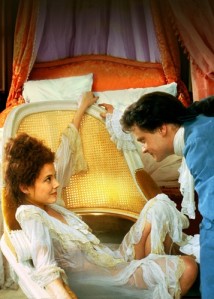Video of Women in Dress Getting in Bath
The Bathing Dress: Fashion in the Georgian Era
April 27, 2013 by Vic
During the 18th century women wore a long flannel shift while bathing, sometimes with lead weights sewn into the hem to keep the skirts from floating up. (Word Wenches: Keeping It Clean.) In Worn Through, Dr. Kimberly Chrisman-Campbell discusses monkeys in art in a blog entitled Monkeys a la mode. The creatures served as satirical stand-ins for humans, much as dogs did in satirical early 20th century poker paintings.

Image @Worn Through. Click on image to go to the source.
I found Chrisman-Campbell's passage about the bath of particular interest:
The bath scene is a rare and realistic image of an eighteenth-century bathroom and bathing ritual; the monkey kicks off her red-heeled shoes (long before Louboutins, these signified that one had been presented at Versailles, an allusion to the family's courtly connections) but she will wear her lace-trimmed white linen chemise in the tub.
One wonders how much the habit of wearing a bathing gown in a bath had to do with modesty. The time it took to prepare for a bath was long and arduous. Water had to be hauled from the well, heated in sufficient quantities, and then hauled up the stairs before the water cooled. One did not take a quick bath in such an instance, but would linger in the tub until the water became too cold for comfort. One imagines that a roaring fire kept the room (and bather) warm. In those days, aristocratic women entertained visitors in their dressing rooms while wearing elaborate dressing gowns. As shown in the scene below, they also entertained visitors while bathing.

Annette Bening and Colin Firth in Valmont
In the film Valmont, Bening's Marquise Isabelle de Merteuil uses the bath as a prop to demonstrate her power and sexuality. Her bathing dress enhances her curves and disguises very little. This film clip shows one delicious bath scene.
In this image from Mr. Vernon, Martha Washington's bathing dress is plain and pedestrian by comparison. It is a mystery to me why the bathing dress was worn, for anyone who has walked in the rain knows how quickly wet clothes can cool the skin. One can only imagine the chilling effect of wet cloth in drafty houses.

Bathing gown. Image @ Mount Vernon
By the late 18th century/early 19th century, bathing dresses were fashionable at seaside resorts. One can readily understand why, for in the image below a man on horseback pulls the bathing machine into the water. The bather peeks out of the door, unwilling to expose herself until all was safe. In fashionable Brighton, men and women bathers were separated and swam from different beaches. Away from prying eyes, some women felt free to bathe nude.

Tide Coming in Fast and a Jibbing Horse", a 19th century engraving from the Illustrated London News which shows how a bathing machine was towed in and out of the sea by a man on horseback. Image @The Brighton Swimming Club
As you can see from this 1813 image from the Costumes of Yorkshire, many women still chose modesty over nudity. The dippers were female, and the male rider on horseback kept well away from view.

Sea Bathing' 1813 From "The costume of Yorkshire, illustrated by a series of forty engravings, being fac-similes of original drawings" NYPL Digital Collection
If modesty was the reason for wearing bathing costumes made from linen or cotton, then their purpose failed. As seen in this 1916 photograph, wet fabric didn't hide the details of the nude body as much as accentuate the curves. The veiling was illusory and the result much sexier than the nude body itself.

Wet suit 1916: Alfred Stieglitz('Ellen Koeniger', 1916, gelatin silver photograph, 11.1 x 9.1, J Paul Getty Museum, Los Angeles)
In an interesting aside, this image of a medieval bath from Leeds Castle shows that bathing wasn't always regarded as a harmful exercise by the British.

Medieval bath, Leeds Castle
Read more about the seaside and seaside fashions on this blog to round out your knowledge of how the Regency folks enjoyed their seaside excursions:
- Seaside Fashions Regency Style
- Perils of the Sea: Shipwrecks off Dorset's Deadly Coast
- Martha Gunn, Brighton's Queen of the Dippers
- Benjamin Beale's Invention for Bathing Machines
woodcockliled1961.blogspot.com
Source: https://janeaustensworld.com/2013/04/27/the-bathing-dress-fashion-in-the-georgian-era/